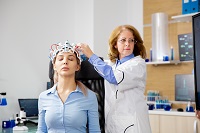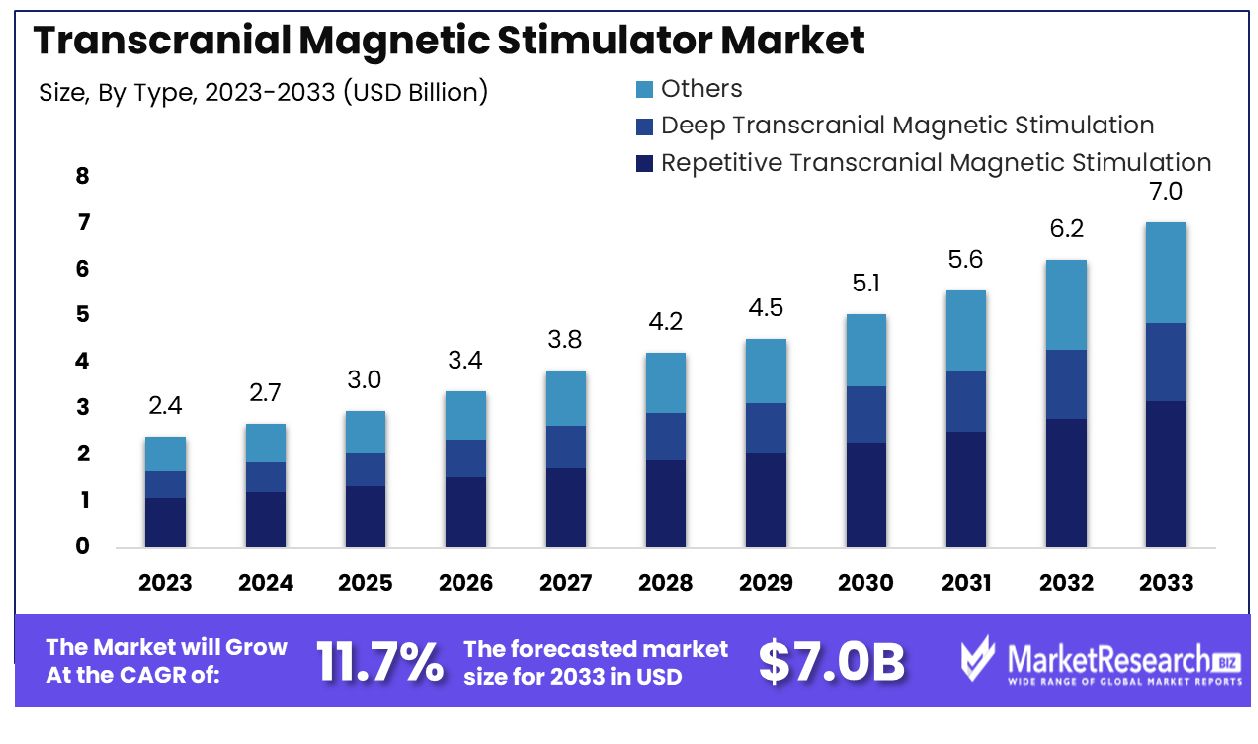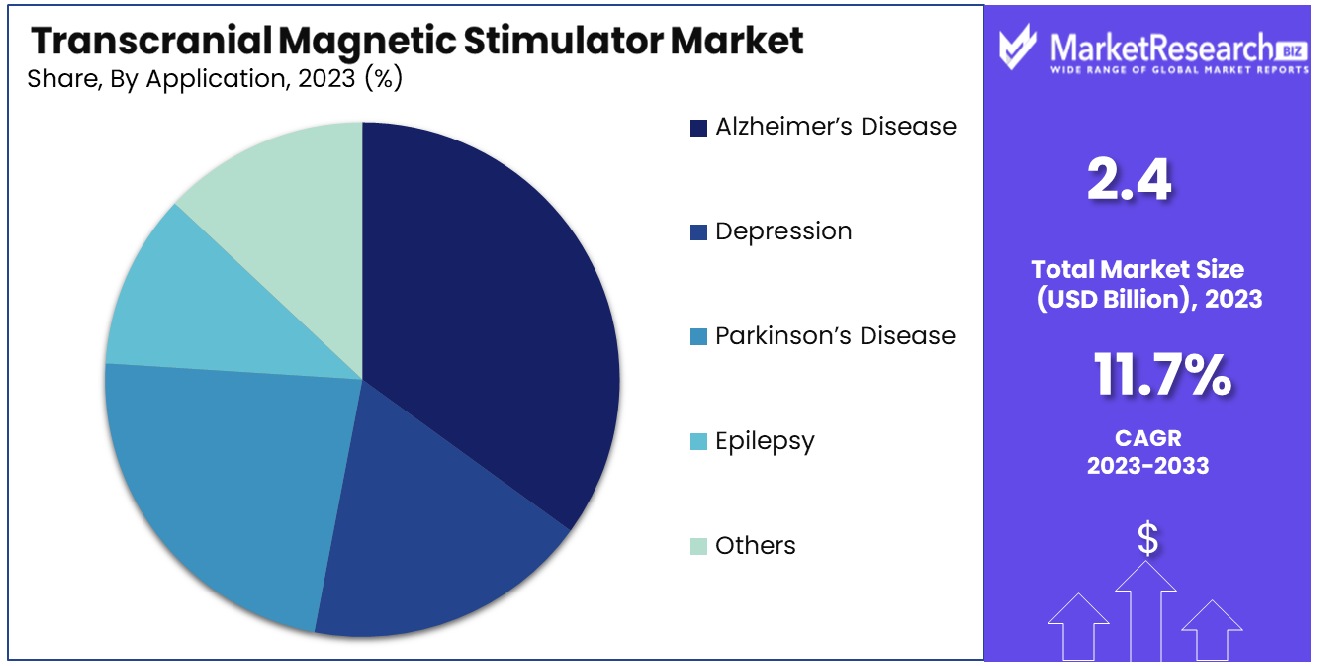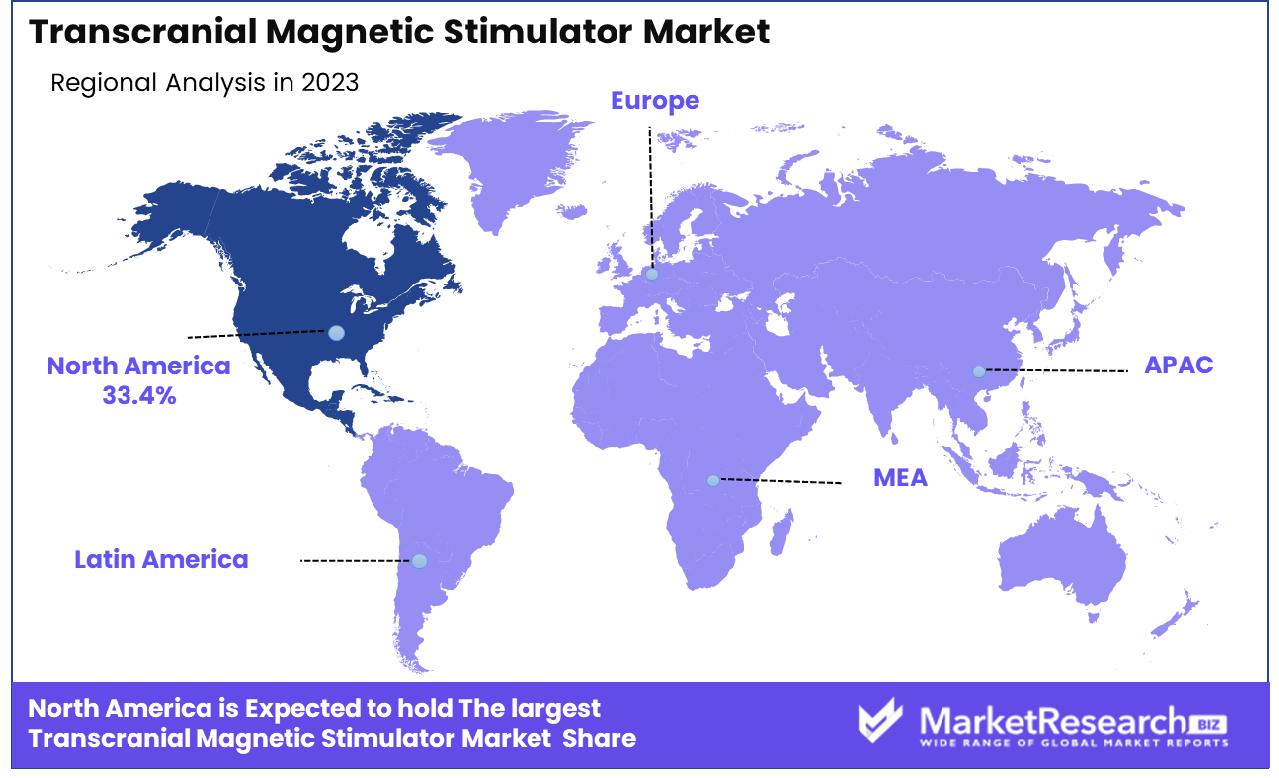
Transcranial Magnetic Stimulator Market By Type (Repetitive Transcranial Magnetic Stimulation, Deep Transcranial Magnetic Stimulation), By Application (Alzheimer’s Disease, Depression, Parkinson’s Disease, Epilepsy), By Age Group(Adults, Children), By Region And Companies - Industry Segment Outlook, Market Assessment, Competition Scenario, Trends, And Forecast 2024-2033
-
42685
-
Jan 2024
-
179
-
-
This report was compiled by Trishita Deb Trishita Deb is an experienced market research and consulting professional with over 7 years of expertise across healthcare, consumer goods, and materials, contributing to over 400 healthcare-related reports. Correspondence Team Lead- Healthcare Linkedin | Detailed Market research Methodology Our methodology involves a mix of primary research, including interviews with leading mental health experts, and secondary research from reputable medical journals and databases. View Detailed Methodology Page
-
Quick Navigation
- Transcranial Magnetic Stimulator Market Size, Share, Trends Analysis
- Transcranial Magnetic Stimulator Market Dynamics
- Transcranial Magnetic Stimulator Market Segmentation Analysis
- Transcranial Magnetic Stimulator Industry Segments
- Transcranial Magnetic Stimulator Market Growth Opportunity
- Transcranial Magnetic Stimulator Market Regional Analysis
- Transcranial Magnetic Stimulator Industry By Region
- Transcranial Magnetic Stimulator Market Share Analysis
- Transcranial Magnetic Stimulator Industry Key Players
- Transcranial Magnetic Stimulator Market Recent Development
- Report Scope
The transcranial magnetic stimulator market was valued at USD 2.4 billion in 2023. It is expected to reach USD 7.0 billion by 2033, growing at a CAGR of 11.7% during the forecast period from 2024 to 2033.
Rising demand for neurological disorders, combined with technological innovations, is driving the market for transcranial magnetic stimulators. TMS stimulates neurons in the brain by applying magnetic fields; it has proven highly effective at alleviating depression as well as treating OCD anxieties, PTSD, Parkinson's disease, Alzheimer's or dementia as well as various forms of sclerosis.

Alzheimer's Disease International estimates that up to 75% of those with dementia but undiagnosed may be living with Alzheimer's. Lower and middle-income regions could see up to 90% of non-diagnosed cases around the world by 2022, and its numbers could nearly double by 2060 unless improvements in medical technology can help slow or stop its progress.
Transcranial magnet stimulation therapy may assist in treating or preventing neurological conditions by stimulating nerve cells with electrical impulses to reduce symptoms associated with neurological conditions.
Transcranial Magnetic Stimulation has become widely utilized across Europe and America over the past two decades to treat depression; more recently Australia adopted TMS to stimulate brain cortex neurons within it. Healthcare companies invest heavily in transcranial magnetic stimulation research and development; two forms are frequently utilized: repetitive transcranial magnetic stimulation (repetition TMS) and deep transcranial magnetic stimulation (deep TMS).
TMS can offer doctors an effective alternative when traditional therapies cannot effectively address neurological conditions, as it's noninvasive, secure, and highly efficient at saving lives while working alongside other therapies. As its popularity continues to increase due to its success at treating most neurological illnesses safely and efficiently - its market will expand over time.
Transcranial Magnetic Stimulator Market Dynamics
Neurological Disorder Treatments Propel TMS Market
Transcranial Magnetic Stimulators (TMS) have experienced an explosive growth rate due to the rising demand for neurological treatments for various conditions. TMS provides a safe and noninvasive method of stimulating the brain which has gained widespread acceptance by medical professionals as an effective therapy option for migraine treatment, depression treatment, and neurological conditions such as stroke.
With an ever-increasing incidence rate for these conditions worldwide, non-pharmacological solutions like TMS have become even more essential to manage them effectively - becoming part of both neurology and mental health areas of expertise worldwide.
Awareness and Infrastructure Boost TMS Adoption
TMS has experienced rapid market expansion due to greater awareness of mental health issues and improvements to healthcare infrastructure. As more medical professionals and patients learn about TMS as an alternative treatment method, its recognition may increase as an effective treatment solution.
Mental healthcare and neurology advances now make incorporating cutting-edge technologies such as TMS into treatment plans more easily, leading to greater acceptance and growth of TMS markets in future years.
R&D Investment Drives TMS Innovations
Increased investments in R&D are integral to the development and expansion of the transcranial magnetic stimulation market. R&D initiatives focus on making TMS technology more user-friendly, accessible, and efficient; with the latest innovations including enhanced targeting capabilities, personalized treatment protocols, and integration with other therapies being born out of ongoing research efforts.
TMS technology advances are key in expanding its use and driving market growth. Evidenced by continued investments in R&D, the market appears to be expanding quickly driven by technological innovations and efforts to better treat mental illnesses. The Transcranial Magnetic Stimulator Market addresses ataxia challenges, offering promising solutions for non-invasive neurostimulation to enhance motor control.
Lack of Awareness in Developing Regions Limits Transcranial Magnetic Stimulator Market Growth
Transcranial Magnetic Stimulator (TMS) market expansion remains severely constrained in developing regions due to limited awareness. TMS, an innovative noninvasive therapy used for stimulating neural activity across various mental and neurological ailments, remains unknown in most countries that could benefit.
Due to limited awareness among healthcare professionals and the general public about the advantages and uses of TMS therapy, its underuse may result in underutilization. If there is insufficient knowledge regarding this technology in these regions, healthcare providers might not even consider TMS therapy as an option for treatment, limiting market acceptance and expansion in those regions.
Shortage of Trained Professionals Restrains Transcranial Magnetic Stimulator Market Expansion
Transcranial magnetic stimulation market growth is constrained by an inadequate pool of qualified experts. TMS equipment requires specialists with specific knowledge to operate efficiently and safely for effective and safe treatment - however many areas lack these professionals.
TMS treatments for patients and health facilities alike have become more limited over time due to these limitations, limiting accessibility for TMS therapy as a treatment option and making TMS treatments less accessible for those in need of this therapy.
Therefore, increasing market coverage of this therapy and making the therapy more accessible are paramount to broadening market coverage and expanding patient accessibility; educational courses for healthcare professionals needing it must become more readily accessible to increase TMS therapy market share while simultaneously expanding patient accessibility.
Transcranial Magnetic Stimulator Market Segmentation Analysis
By Type Analysis
Repetitive Transcranial Magnetic Stimulation (rTMS) has quickly become the market leader among transcranial magnetic stimulators due to its widespread acceptance and effectiveness in treating neurological and psychological conditions, including depressive disorder. It works by administering magnetic impulses via scalp electrodes to alter neuron activity; its noninvasive nature has earned rTMS the trust of practitioners as it helps alleviate depression-related symptoms quickly. Furthermore, research continues on ways it could treat other neurological disorders while further expanding its market presence.
Deep Transcranial Magnetic Stimulation (DTMS) and its variations have quickly become a highly sought-after treatment option in recent years, often used to address brain regions affected by disorders like obsessive-compulsive disorder or major factors of depression. Furthermore, new variations are being created to further increase its efficacy and effectiveness for treating various neuropsychiatric illnesses.
By Application Analysis
Alzheimer's Disease has proven itself a prime candidate for transcranial magnetic stimulation (rTMS). With an ever-increasing global prevalence and no effective treatments available, transcranial magnetic stimulation offers an alternative therapy approach that has proven its ability to help improve cognitive and memory functions among those suffering from Alzheimer's Disease while providing non-pharmacological approaches for treating its illness. Its popularity can be attributed to both international research on neurodegenerative disorders as well as worldwide acceptance.

Depression, Parkinson's Disease, epilepsy, and other neurological disorders are also key areas for the application of rTMS in the market. Depression has proven particularly responsive to this treatment approach with ample research supporting its efficacy; and Parkinson's disease and epilepsy treatment research is currently ongoing, offering new treatment solutions.
By Age Group Analysis
Adults segment represents the greatest segment of the population for transcranial magnetic stimulation treatments. This could be attributed to their higher prevalence of mental and neurological illnesses as well as greater understanding and acceptance of transcranial magnetic stimulation therapy among this age range, which has many applications from treating major depression to managing chronic pain in this population.
Children as a group are becoming more aware of the advantages rTMS may provide them in treating certain disorders such as autism spectrum disorders and ADHD (ADHD), although their industry growth remains more measured due to developmental issues in their brains and individual treatment strategies that must be tailored specifically.
Transcranial Magnetic Stimulator Industry Segments
By Type
- Repetitive Transcranial Magnetic Stimulation
- Deep Transcranial Magnetic Stimulation
- Others
By Application
- Alzheimer’s Disease
- Depression
- Parkinson’s Disease
- Epilepsy
- Others
By Age Group
- Adults
- Children
Transcranial Magnetic Stimulator Market Growth Opportunity
Growing Acceptance of Non-Invasive Treatment Options Boosts Transcranial Magnetic Stimulator Market
Transcranial Magnetic Stimulators (TMSs) offer numerous growth opportunities in the market due to the rising acceptance and demand for noninvasive treatments within medical practice.
TMS or transcranial magnetic stimulation has quickly become one of the go-to treatments for anxiety and depression. This is likely owing to its lower risk profile compared with more extensive approaches; healthcare professionals continue to look for more efficient alternatives than traditional invasive procedures; further reinforcing its rise.
Increasing Awareness and Acceptance of TMS Enhances Market Potential
Transcranial Magnetic Stimulation (TMS) therapy has gained recognition both among medical professionals and patients, thus increasing its market. Professionals are becoming aware of its effectiveness in treating mental health conditions while more patients turn to TMS therapy as a treatment option.
Patient testimonials, clinical research findings, and increasing endorsement from the medical community are fuelling TMS' popularity surge. TMS' acceptance is increasingly accepted within mainstream mental healthcare as evidenced by positive clinical outcomes and increasing insurance coverage - signaling significant potential growth opportunities ahead for this therapy option.
Transcranial Magnetic Stimulator Market Regional Analysis
North America Dominates with 33.4% Market Share in Transcranial Magnetic Stimulator Market
North America holds 33.4% of the magnetic stimulation market. This share can be attributed to its advanced healthcare system and commitment to mental health awareness and treatment. TMS treatment was initially popularized in Canada and the US as pioneers for adopting novel neurological treatments like TMS for the treatment of depression.

Key market players worldwide investing heavily in healthcare R&D are fuelling its continued dominance within this market space; additionally, the rising awareness surrounding mental health as well as acceptance of non-invasive therapies like TMS have also significantly contributed to its expansion.
North American market dynamics are driven by the increasing prevalence of neurological disease conditions and demand for effective non-pharmacological treatment options, specifically transcranial magnetic stimulation (TMS). A robust scientific research infrastructure that facilitates ongoing studies and trials regarding TMS efficacy plays a vital role in market development; regulations and health policies implemented across North America that facilitate approval and acceptance of new medical devices also play a vital part.
Europe: Focus on Innovation and Mental Health Awareness
European market drivers for TMS include innovation in mental health research and high levels of awareness surrounding mental illness. A strong healthcare infrastructure in place in Europe along with major medical device firms contributes to the market's expansion. Europe has long been considered a pioneering nation when it comes to researching mental illness research; research dedicated to mental wellbeing research as well as modern treatments such as TMS are driving forces behind its market dynamics.
Asia-Pacific: Growing Healthcare Sector and Technological Adoption
Asia-Pacific TMS Market Development | TMS is expanding, due to a rise in health sector development and technological innovation. Countries such as Japan, China, and Australia are witnessing an increase in demand for new treatments for mental health problems; improving infrastructure provides greater awareness regarding mental health concerns while rising middle-class populations seek the latest medical technology treatments; investments made into healthcare technology combined with neurologic disorders provide tremendous growth potential in this region.
Transcranial Magnetic Stimulator Industry By Region
North America
- The US
- Canada
- Rest of North America
Europe
- Germany
- France
- The UK
- Spain
- Italy
- Russia
- Netherlands
- Rest of Europe
Asia-Pacific
- China
- Japan
- South Korea
- India
- New Zealand
- Singapore
- Thailand
- Vietnam
- Rest of Asia Pacific
Latin America
- Brazil
- Mexico
- Rest of Latin America
Middle East & Africa
- South Africa
- Saudi Arabia
- UAE
- Rest of Middle East & Africa
In the Transcranial Magnetic Stimulator Market, a critical area for non-invasive neurostimulation treatments, the major companies listed are central to driving innovation and adoption of this technology. BrainsWay is renowned for its pioneering Deep TMS technology, offering advanced solutions in treating a variety of neurological and psychiatric disorders, and influencing market trends towards deeper brain stimulation.
Magstim and MagVenture A/S are key players known for their contributions to both clinical and research applications of TMS. Their product range, which includes both diagnostic and therapeutic solutions, underlines the market's focus on versatility and scientific advancement.
Nexstim stands out for its navigated brain stimulation technology, bringing precision to TMS treatments and enhancing the effectiveness of therapy. This reflects the market's key trend towards personalized and targeted treatment approaches.
Transcranial Magnetic Stimulator Industry Key Players
- BrainsWay Ltd.
- Magstim
- Nexstim Plc
- Salience
- MagVenture A/S
- ENeura, Inc.
- Soterix Medical, Inc.
Transcranial Magnetic Stimulator Market Recent Development
- In 2023, There have been significant advancements in brain stimulation techniques, such as transcranial magnetic stimulation (TMS). Researchers have continued to explore the potential of TMS in modulating neural activity and promoting neuroplasticity. These techniques are being investigated for their applications in enhancing learning, memory, and rehabilitation, particularly in individuals with neurological disorders.
- In 2023, Neuralia TMS, a leader in mental health solutions, announced the launch of its Transcranial Magnetic Stimulation (TMS) treatment in Melbourne, Victoria. This innovative approach uses magnetic fields to activate brain regions associated with mood regulation to treat depression.
- In July 2023, The Medical University of South Carolina (MUSC) received funding of over $3.7 million from the National Institute on Aging to research the use of TMS in treating patients with depression.
- In 2023, Northeastern University announced plans to acquire a revolutionary new brain stimulator capable of delivering transcranial magnetic stimulation (TMS). This machine is expected to have a significant impact on various scientific fields.
- In May 2021, Neuroelectrics, based in Barcelona, Spain, with offices in Cambridge, Massachusetts, announced that it had raised $17.5 million in a Series A financing round led by Morningside Ventures. The company planned to use the funds to develop its non-invasive transcranial electrical stimulation (tES) therapeutic platform into clinical trials.
- In October 2020, Rune Labs, Inc. announced that it secured a $5 million seed round led by DigiTx Partners, raising a total of $7.3 million. This funding round included participation from earlier investors such as TruVenturo, Moment Ventures, Loup Ventures, and Sabbatical Ventures. Rune Labs is a developer of software that enables the development and delivery of neuroscience therapeutics. They specialize in neuromodulation therapies, including Transcranial Magnetic Stimulation (TMS) and Deep Brain Stimulation (DBS).
Report Scope
Report Features Description Market Value (2023) USD 2.4 Billion Forecast Revenue (2033) USD 7.0 Billion CAGR (2024-2032) 11.7% Base Year for Estimation 2023 Historic Period 2016-2023 Forecast Period 2024-2033 Report Coverage Revenue Forecast, Market Dynamics, COVID-19 Impact, Competitive Landscape, Recent Developments Segments Covered By Type (Repetitive Transcranial Magnetic Stimulation, Deep Transcranial Magnetic Stimulation, Others), By Application (Alzheimer’s Disease, Depression, Parkinson’s Disease, Epilepsy, Others), By Age Group(Adults, Children) Regional Analysis North America - The US, Canada, Rest of North America, Europe - Germany, France, The UK, Spain, Italy, Russia, Netherlands, Rest of Europe, Asia-Pacific - China, Japan, South Korea, India, New Zealand, Singapore, Thailand, Vietnam, Rest of Asia Pacific, Latin America - Brazil, Mexico, Rest of Latin America, Middle East & Africa - South Africa, Saudi Arabia, UAE, Rest of Middle East & Africa Competitive Landscape BrainsWay Ltd., Magstim, Nexstim Plc, Salience, MagVenture A/S, ENeura, Inc., Soterix Medical, Inc. Customization Scope Customization for segments, region/country-level will be provided. Moreover, additional customization can be done based on the requirements. Purchase Options We have three licenses to opt for Single User License, Multi-User License (Up to 5 Users), Corporate Use License (Unlimited User and Printable PDF)
-
-
- BrainsWay Ltd.
- Magstim
- Nexstim Plc
- Salience
- MagVenture A/S
- ENeura, Inc.
- Soterix Medical, Inc.




